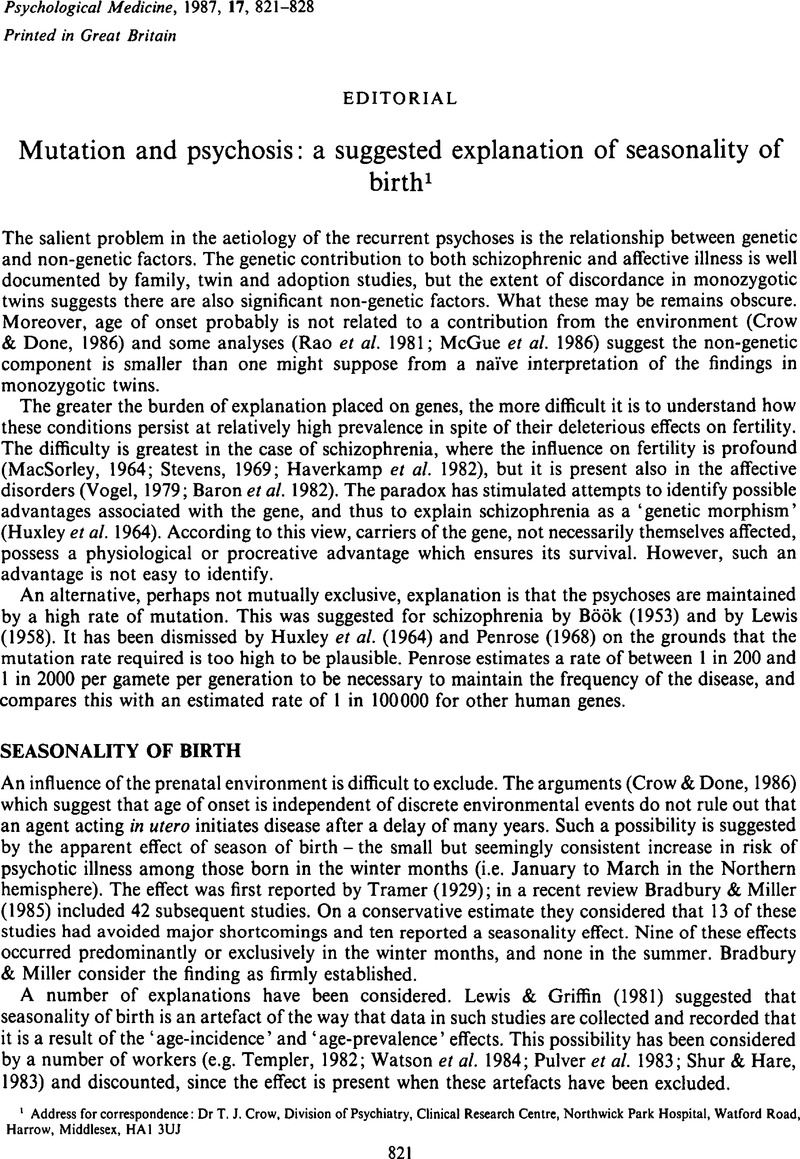Crossref Citations
This article has been cited by the following publications. This list is generated based on data provided by Crossref.
Crow, T. J.
1988.
[No Title].
British Journal of Psychiatry,
Vol. 152,
Issue. 3,
p.
431.
Crow, T. J.
1988.
Sex Chromosomes and Psychosis.
British Journal of Psychiatry,
Vol. 153,
Issue. 5,
p.
675.
Persaud, R.
1988.
[No Title].
British Journal of Psychiatry,
Vol. 153,
Issue. 2,
p.
261.
Crow, T. J.
1988.
The Viral Theory of Schizophrenia.
British Journal of Psychiatry,
Vol. 153,
Issue. 4,
p.
564.
Fañanas, L.
Marti-Tusquets, J. L.
and
Bertranpetit, J.
1989.
Seasonality of birth in schizophrenia.
Social Psychiatry and Psychiatric Epidemiology,
Vol. 24,
Issue. 5,
p.
266.
Crow, T. J.
DeLisi, L. E.
and
Johnstone, E. C.
1989.
Genetics of Neuropsychiatric Diseases.
p.
199.
Crow, T. J.
1990.
Search for the Causes of Schizophrenia.
p.
383.
Dalén, P.
1990.
Search for the Causes of Schizophrenia.
p.
7.
Leach, John
1991.
The Functional Psychoses – Are Oncogenes Involved in Their Pathogenesis? Some Speculations.
British Journal of Psychiatry,
Vol. 158,
Issue. 4,
p.
563.
1991.
Familial, obstetric, and other clinical correlates of minor physical anomalies in schizophrenia.
American Journal of Psychiatry,
Vol. 148,
Issue. 4,
p.
479.
Richardson Andrews, R.C.
1992.
An update of the zinc deficiency theory of schizophrenia. Identification of the sex determining system as the site of action of reproductive zinc deficiency.
Medical Hypotheses,
Vol. 38,
Issue. 4,
p.
284.
Nielsen, Søren
1992.
Seasonal variation in anorexia nervosa? Some preliminary findings from a neglected area of research.
International Journal of Eating Disorders,
Vol. 11,
Issue. 1,
p.
25.
Gupta, Sunjai
and
Murray, Robin M.
1992.
The Relationship of Environmental Temperature to the Incidence and Outcome of Schizophrenia.
British Journal of Psychiatry,
Vol. 160,
Issue. 6,
p.
788.
Gupta, S.
1993.
Can environmental factors explain the epidemiology of schizophrenia in immigrant groups?.
Social Psychiatry and Psychiatric Epidemiology,
Vol. 28,
Issue. 6,
p.
263.
Mouridsen, Svend Erik
Rich, Bente
and
Isager, Torben
1993.
Brief report: Parental age in infantile autism, autistic-like conditions, and borderline childhood psychosis.
Journal of Autism and Developmental Disorders,
Vol. 23,
Issue. 2,
p.
387.
Torrey, E.Fuller
Miller, Judy
Rawlings, Robert
and
Yolken, Robert H
1997.
Seasonality of births in schizophrenia and bipolar disorder: a review of the literature.
Schizophrenia Research,
Vol. 28,
Issue. 1,
p.
1.
Fuller Torrey, E
2000.
Familial and genetic mechanisms in schizophrenia.
Brain Research Reviews,
Vol. 31,
Issue. 2-3,
p.
113.
Kaminsky, Z
Tochigi, M
Jia, P
Pal, M
Mill, J
Kwan, A
Ioshikhes, I
Vincent, J B
Kennedy, J L
Strauss, J
Pai, S
Wang, S-C
and
Petronis, A
2012.
A multi-tissue analysis identifies HLA complex group 9 gene methylation differences in bipolar disorder.
Molecular Psychiatry,
Vol. 17,
Issue. 7,
p.
728.



